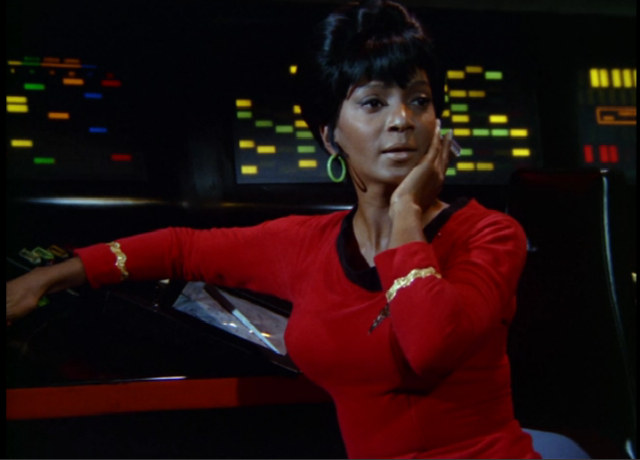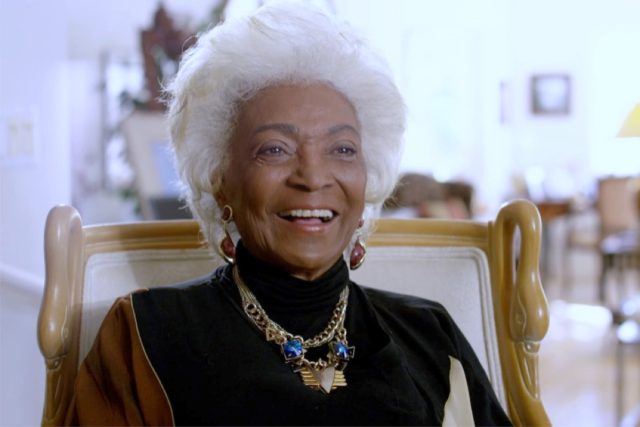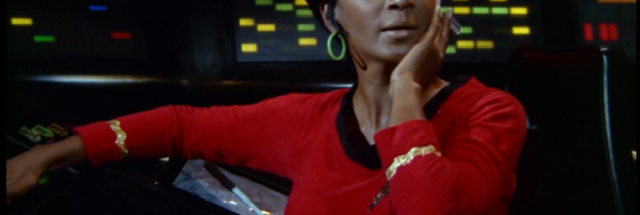
Nichelle Nichols made TV history with her portrayal of Nyota Uhura in Star Trek: the Original Series.
CBS
Actress Nichelle Nichols—who made history with her portrayal of Nyota Uhura on Star Trek: The Original Series—died Saturday, July 30, at the age of 89. Her son Kyle Johnson announced Nichols’ passing on her official Instagram account, saying his mother had died of natural causes. (The LA Times reported cause of death as heart failure.) Deadline Hollywood confirmed her passing with Gilbert Bell, her talent manager and business partner of 15 years. Nichols suffered a mild stroke in 2015 and was diagnosed with dementia in 2018. She rarely appeared in public after that.
(Last year we wrote about Woman in Motion, a new documentary about Nichols and her recruitment work for NASA, directed by Todd Thompson (streaming on Paramount+). Much of the following is adapted from that text.)
Nichols started her career as a dancer and singer. She had wanted to become the first Black ballerina, and by age 14 landed her first gig at the Sherman Hotel in Chicago. She subsequently toured the US, Canada, and Europe with Duke Ellington and Lionel Hampton before settling in Los Angeles in 1960 to pursue acting.
Among Nichols’ first roles was playing a Black soldier’s fiancee on a short-lived series called The Lieutenant, produced by Gene Roddenberry. The episode (which never aired) was entitled “To Set It Right” and dealt explicitly with racial prejudice. So when Roddenberry began developing a new series, originally titled Wagon Train to the Stars, he thought of her for one of the roles. That show became Star Trek, and Nichols made history as Uhura. (In her autobiography, Nichols revealed that she had been romantically involved with Roddenberry before he met his wife, Majel Hudec, although the affair ended well before she was cast in Star Trek.)
I shall have more to say about the trailblazing, incomparable Nichelle Nichols, who shared the bridge with us as Lt. Uhura of the USS Enterprise, and who passed today at age 89. For today, my heart is heavy, my eyes shining like the stars you now rest among, my dearest friend.
— George Takei (@GeorgeTakei) July 31, 2022
Nichols very nearly quit the series after the first season, frustrated with what she perceived to be a constantly diminished role. But a chance encounter with Martin Luther King Jr. changed her mind. “You cannot, you cannot,” she recalled him saying when she told him she wanted to leave the series. “For the first time on television, we will be seen as we should be seen every day, as intelligent, quality, beautiful people, who can sing, dance, and can go to space, who are professors, lawyers. If you leave, that door can be closed because your role is not a Black role, and it is not a female role, he can fill it with anybody, even an alien.”
With co-star William Shatner, Nichols also engaged in what is widely touted as the first interracial kiss on US scripted television in the 1968 TOS episode, “Plato’s Stepchildren.” As Cyrus Farivar wrote for Ars in 2018:
The smooching scene has been commonly referred to as television’s first interracial kiss—but there’s compelling evidence that it actually wasn’t. Still, this bisou remains an iconic Star Trek moment at a time in America when there were very few mainstream media depictions of mixed-race intimacy. After all, “Plato’s Stepchildren” aired just 18 months after the Supreme Court decided the case of Loving v. Virginia, which overturned all bans on interracial marriage in the United States.
According to The Hollywood Reporter, the scene in “Plato’s Stepchildren” was shot one way with the actors’ lips meeting (as the show’s creator, Gene Roddenberry, wrote it) and another where they don’t. However, actors William Shatner (Kirk) and Nichelle Nichols (Uhura) both flubbed the non-kiss takes so that the director (who was concerned about possible backlash) would be forced to use the real McCoy.
After the original series ended, Nichols attended a 1975 Star Trek convention, where NASA’s director of science was also speaking. He expressed his admiration for Uhura. She in turn spoke about her love of space and NASA, but also of her sense of disenfranchisement. When NASA claimed it couldn’t find qualified Black people, Nichols didn’t buy it, insisting that Black people and women weren’t applying to the program because they didn’t believe NASA was serious about giving them a chance. So she became a NASA spokesperson through her company, Women in Motion.

Paramount+
Nichols traveled all over the country, trying to recruit women and minorities to the shuttle program. When she started, 100 of NASA’s aspiring recruits were women, and just 35 were minorities. By the time she submitted her final report, those numbers had swelled to 1,649 women and 1,000 minorities in a group of 8,000.
Among those recruits were Sally Ride and Judith Resnick—the first and second American women in space, respectively—as well as Guion Bluford Jr. and Ron McNair, the first and second Black astronauts in space, and Ellison Onizuka, the first Asian American in space. Col. Frederick D. Gregory also heeded the call and wound up serving on three shuttle missions before becoming NASA deputy administrator.
McNair, Resnick, and Onizuka were all crew members on the Space Shuttle Challenger for the doomed mission STS-51-L. The shuttle broke up in the air just 73 seconds after launch on January 28, 1986, killing everyone on board. Nichols was devastated by the loss, particularly of Resnick, with whom she had become quite close.
In his Instagram post, Kyle Johnson asked for privacy for the family as they grappled with their loss. “Her light … like the ancient galaxies now being seen for the first time, will remain for us and future generations to enjoy, learn from, and draw inspiration,” he wrote. “Hers was a life well lived and as such a model for us all.”








